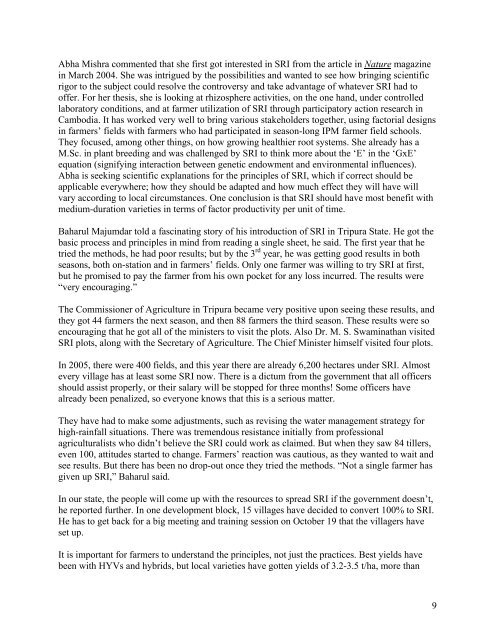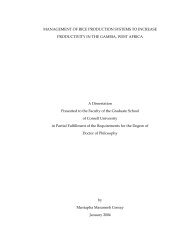REPORT FROM 2ND INTERNATIONAL RICE CONGRESS, NEW ...
REPORT FROM 2ND INTERNATIONAL RICE CONGRESS, NEW ...
REPORT FROM 2ND INTERNATIONAL RICE CONGRESS, NEW ...
Create successful ePaper yourself
Turn your PDF publications into a flip-book with our unique Google optimized e-Paper software.
Abha Mishra commented that she first got interested in SRI from the article in Nature magazine<br />
in March 2004. She was intrigued by the possibilities and wanted to see how bringing scientific<br />
rigor to the subject could resolve the controversy and take advantage of whatever SRI had to<br />
offer. For her thesis, she is looking at rhizosphere activities, on the one hand, under controlled<br />
laboratory conditions, and at farmer utilization of SRI through participatory action research in<br />
Cambodia. It has worked very well to bring various stakeholders together, using factorial designs<br />
in farmers’ fields with farmers who had participated in season-long IPM farmer field schools.<br />
They focused, among other things, on how growing healthier root systems. She already has a<br />
M.Sc. in plant breeding and was challenged by SRI to think more about the ‘E’ in the ‘GxE’<br />
equation (signifying interaction between genetic endowment and environmental influences).<br />
Abha is seeking scientific explanations for the principles of SRI, which if correct should be<br />
applicable everywhere; how they should be adapted and how much effect they will have will<br />
vary according to local circumstances. One conclusion is that SRI should have most benefit with<br />
medium-duration varieties in terms of factor productivity per unit of time.<br />
Baharul Majumdar told a fascinating story of his introduction of SRI in Tripura State. He got the<br />
basic process and principles in mind from reading a single sheet, he said. The first year that he<br />
tried the methods, he had poor results; but by the 3 rd year, he was getting good results in both<br />
seasons, both on-station and in farmers’ fields. Only one farmer was willing to try SRI at first,<br />
but he promised to pay the farmer from his own pocket for any loss incurred. The results were<br />
“very encouraging.”<br />
The Commissioner of Agriculture in Tripura became very positive upon seeing these results, and<br />
they got 44 farmers the next season, and then 88 farmers the third season. These results were so<br />
encouraging that he got all of the ministers to visit the plots. Also Dr. M. S. Swaminathan visited<br />
SRI plots, along with the Secretary of Agriculture. The Chief Minister himself visited four plots.<br />
In 2005, there were 400 fields, and this year there are already 6,200 hectares under SRI. Almost<br />
every village has at least some SRI now. There is a dictum from the government that all officers<br />
should assist properly, or their salary will be stopped for three months! Some officers have<br />
already been penalized, so everyone knows that this is a serious matter.<br />
They have had to make some adjustments, such as revising the water management strategy for<br />
high-rainfall situations. There was tremendous resistance initially from professional<br />
agriculturalists who didn’t believe the SRI could work as claimed. But when they saw 84 tillers,<br />
even 100, attitudes started to change. Farmers’ reaction was cautious, as they wanted to wait and<br />
see results. But there has been no drop-out once they tried the methods. “Not a single farmer has<br />
given up SRI,” Baharul said.<br />
In our state, the people will come up with the resources to spread SRI if the government doesn’t,<br />
he reported further. In one development block, 15 villages have decided to convert 100% to SRI.<br />
He has to get back for a big meeting and training session on October 19 that the villagers have<br />
set up.<br />
It is important for farmers to understand the principles, not just the practices. Best yields have<br />
been with HYVs and hybrids, but local varieties have gotten yields of 3.2-3.5 t/ha, more than<br />
9
















